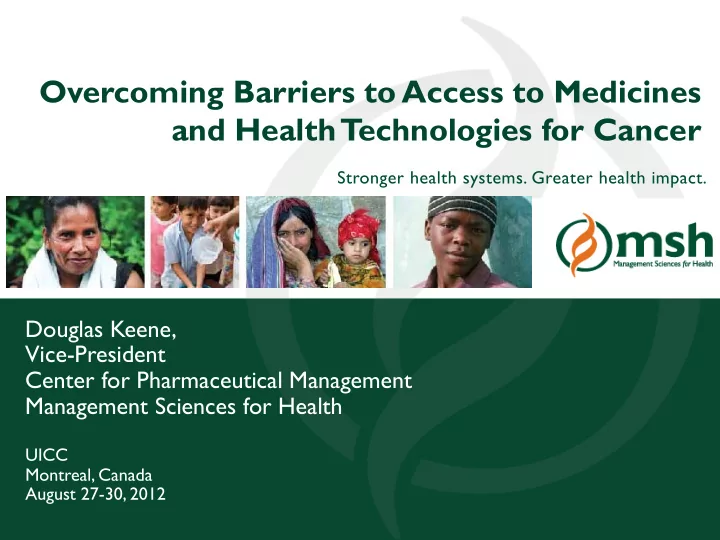

Overcoming Barriers to Access to Medicines and Health T echnologies for Cancer Stronger health systems. Greater health impact. Douglas Keene, Vice-President Center for Pharmaceutical Management Management Sciences for Health UICC Montreal, Canada August 27-30, 2012 Management Sciences for Health 1
Outline ! Barriers to access to cancer medicines and technologies ! Pharmaceutical systems approach ! Affordable access • Price reduction strategies • Procurement options • Quality, safety, and regulation • Non-price barriers to palliation and pain control ! Engaging the private sector • Access to existing medicines, vaccines, and technologies • Product innovation Management Sciences for Health 2
Cancer treatment is unaffordable in most low and many middle income countries Philippines: cervical cancer treatment x2 annual income Pakistan: chemotherapy for leukemia = $20,000, x7 annual income Rwanda: treatment of some cancers, if available, x50+ annual income In most low income countries 50-90% of medicines out of pocket; includes those • for chronic conditions • 17/24 WHO essential cancer medicines unavailable or unaffordable in developing countries • Cancer medicines remain unaffordable in sub-Saharan Africa, , India, Latin America, and middle-income countries such as Egypt and Morocco. Domingo'EJ,'Dy'Echo'AV.Epidemiology,'preven7on'and'treatment'of'cervical'cancer'in'the'Philippines.'J'Gynecol'Oncol.'2009'Mar;20(1):11H6. ' Aziz'Z.'Across'genera7ons:'cancer'treatment'in'developing'countries.'J'Clin'Oncol.'2008;26(30):4990H1' Quick'JD.'Essen7al'medicines'twentyHfive'years'on:'closing'the'access'gap.'Health'Policy'Plan.'2003'Mar;18(1):1H3.' World'Health'Report'(2010).'Op7ons'for'financing'and'op7mizing'medicines'in'resourceHpoor'countries.'' Boyle'P,'Levin'B:'World'Cancer'Report'2008.'WHO:'WHO'press;'2008.' Orem'J,'Wabinga'H.'The'roles'of'na7onal'cancer'research'ins7tu7ons'in'evolving'a'comprehensive'cancer'control'program'in'a'developing'country:'experience'from'Uganda.'Oncology.' 2009;77(5):272H80.' 'Meremikwu'MM,'et'al'(2005).'Socioeconomic'constraints'to'effec7ve'management'of'Burkib's'lymphoma'in'southHeastern'Nigeria.'Trop'Med'Int'Health.'10(1):92H8' Cancer'Pa7ents'Aid'Associa7on,'India.'Cancer'drugsHPricing'and'Patents,'September'2010.'Department'of'Industrial'Policy'and'Promo7on,'Ministry'of'Commerce'and'Industry,'Government'of' India.'hbp://dipp.nic.in/iprHfeedback/Feedback_01_CL_10September2010.pdf;accessed'Dec'8,'2010' Howard'SC,'Marinoni'M,'Cas7llo'L,'et'al.'Improving'outcomes'for'children'with'cancer'in'lowHincome'countries'in'La7n'America:'a'report'on'the'recent'mee7ngs'of'the'Monza'Interna7onal' School'of'Pediatric'Hematology/Oncology'(MISPHO)HPart'I.'Pediatr'Blood'Cancer.'2007;48:364–369.' ElHZawahry'HM'et'al.'Cost'and'outcome'of'treatment'of'adults'with'acute'myeloid'leukemia'at'the'Na7onal'Cancer'Ins7tuteHEgypt.'J'Egypt'Natl'Canc'Inst.'2007;19(2):106H13' Boutayeb'S'et'al'(2010).'Es7ma7on'of'the'cost'of'treatment'by'chemotherapy'for'early'breast'cancer'in'Morocco.'Cost'Eff'Resour'Alloc.'2010;8:16' ' Management Sciences for Health 3
For many treatable cancers, chemotherapy costs are a major share of total treatment costs Nigeria:(Direct(costs(of(trea/ng(a(child(with(Burki8’s(Lymphoma( ' Cost(per(child(treated((US($)(( %( Laboratory'tests'H'First'diagnosis'' '''''''' '18.90'' 12%' Cytotoxic(drugs( ( (103.80(( 63%( Laboratory'tests'H'FollowHup' '9.60' 6%' Hospital'and'other'costs' '31.50'' 19%' Total'direct'cost' '163.80'' 100%' Meremikwu'MM,'et'al.Socioeconomic'constraints'to'effec7ve'management'of'Burkib's'lymphoma'in'southHeastern'Nigeria.' Trop%Med%Int%Health '2005.' 10 :'92H98' Management Sciences for Health 4
Pharmaceutical systems approach to access National/Local Level Global/Regional Level Information-sharing, networking, coordination of stakeholders for access to cancer care and control between WHO, IARC, GTF.CCC, IUCC, IAEA, INCTR, others Selection Adapt guidelines for local Revise guidelines as Guidelines for prevention, detection, Essential package for treatment , and palliative care & settings; consider supply and needed based on cancer care and control essential medicines list for cancer maintenance for equipment feedback/experience Pricing All products: Elimination/ Contain distribution and Price information exchange for cancer products reduction of tariffs, taxes, fees dispensing mark-ups Generic/multi-source products: bulking purchasing, generic substitution Manufacturer engagement for Supply to national/local brand and generics cancer programs Brand/single-source products: price negotiation, donations, direct price controls Innovative service delivery Procurement Innovative financing: Develop global/regional Use local procurement mechanism/s as local and global procurement mechanism/s appropriate Demand & cost for cancer care & Demand forecast for Ensure supply and maintenance contracts for treatment cancer products diagnostic, radiotherapy, other equipment Quality, Safety, Regulation Include quality experience in global price Quality assurance process linked Expedited registration for products not monitoring to procurement mechanism available Management Sciences for Health 5
Cost of cancer medicines – up to 10-fold variation in costs among generic sources $2'500'' $2'000'' $1'500'' $1'000'' $500'' $0'' Management Sciences for Health 6
99% reduction of ARV prices through “leap frog” of competition and differential pricing Initial Prices 12000 $12,000 Differential3Pricing Competitive3Pricing 10000 8000 US'$'per'person'per'year 6000 4000 2000 0 1996 1997 1998 2000 2001 2004 2005 2008 2011 Year Management Sciences for Health 7
Price reduction strategies for cancer medicines and vaccines Generic/Mul/OSource( Brand/SingleOSource( ' • Compe77ve'purchasing' • Differen7al'pricing' • ''Pooled'procurement' • Dona7ons' • ''Transfer'of'technology' • ‘Licensed'compe77on’' ' • Compulsory'licensing' ' ' Management Sciences for Health 8
Global Procurement Mechanisms Program( Focus( Mul/lateral(/(DonorOSupported( Stop'TB/Global'Drug'Facility'(GDF)' Tuberculosis' Global'Fund'Voluntary'Pooled'Procurement' AIDS,'TB,'Malaria'–'medicines,' diagnos7cs,'bednets' Program'(VPP)' PEPFAR/USAID'Supply'Chain'Management'System' AIDS'medicines'and'diagnos7cs'' (SCMS), Partnership'for'Supply'Chain'Management' Asthma'Drug'Facility' Asthma'medicines'' UNICEF' Essen7al'medicines,'vaccines,' health'commodi7es'for'children' NonOprofit(procurement(agencies((illustra/ve)( " 'Ac7on'Medeor' " 'ECHO' " 'IDA'Founda7on'' Essen7al'medicines'and'other' health'commodi7es;'in'some' " 'IMRES' " 'Mission'Pharma' " 'Orbipharma' " Trimed' cases'healthHrelated'equipment' Management Sciences for Health 9
Engaging the Private Sector – Examples of Current and Needed Actions Access to existing medicines, vaccines, technologies • South-south clinical trials using existing agents to treat other cancers – Cuba with 20 LMC, 7 developed countries with nimotuzumab • North-south transfer of production technology – Eli Lilly technology transfer for off-patent MDR-TB to producers in China, India, S. Africa Product innovation • Expansion of oral formulations for existing generic agents would reduce burden on staff, patients, transport, and increase treatment completion • Synthetic paclitaxel and synthetic derivatives (currently high cost because it’s sourced from the bark of the Pacific yew tree) • Among 19 global health challenges, cancer received 2nd highest number of applications (26) to commercialize low cost health technologies (WHO) • ‘Frugal innovation’ or ‘reverse innovation’ in/for India, Chinese, other large low- income markets for radiotherapy, ultrasound, mammography Management Sciences for Health 10
Major Recommendations 1. All products – WHO/inter’l clinical guidelines and essential medicines lists 2. Generic meds & vaccs – sources & prices information, competitive pooled procurement from qualified suppliers 3. Single-source meds & vaccs – negotiation, donation, ‘licensed competition’ 4. T echnologies for detection, diagnosis, treatment – training, standardization, sources and prices info, support, telemedicine 5. Procurement – add cancer medicines to existing global and regional mechanisms – no new cancer-specific procurement organizations 6. Quality, safety, regulation, palliation, pain control – each are vital 7. Private sector – active engagement to expand access to existing products & encourage targeted ‘frugal’ innovation Management Sciences for Health 11
Stronger health systems. Greater health impact. Saving lives and improving the health of the world’s poorest and most vulnerable people by closing the gap between knowledge and action in public health. Management Sciences for Health 12
Recommend
More recommend